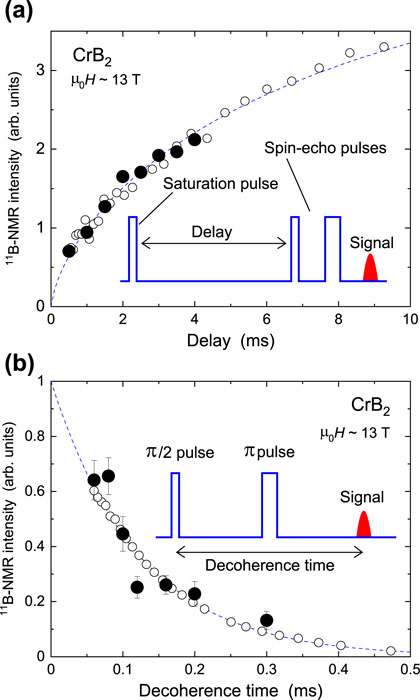NMR Relaxation Time Measurements in Pulsed Field
PI of Joint-use project: Y. IharaHost lab: Kindo and Kohama Groups
Interesting electronic states are frequently found in magnetic fields, where magnetic interactions inherent in material compete with magnetic energy provided by the external magnetic fields. To cause significant impact on the electronic state, extremely high magnetic fields generated by the pulsed-field technology should be applied to the material. The recent advances in pulsed-field technology allow us to access novel field-induced quantum states by its ability to generate extreme magnetic fields. However, various experiments in pulsed field have been a challenge because of the short duration of field generation time. In this work, we incorporate a versatile NMR spectrometer with the dynamically controlled pulsed field to perform NMR measurement in pulsed field and demonstrate the nuclear spin-lattice and spin-spin relaxation rate measurements.
NMR experiment in pulsed field was difficult because the resonant frequency determined by the external field strength continuously and rapidly changes following the pulsed-field profile. Previously the field-sweep NMR spectrum has been obtained by quickly recording the NMR intensity during the rapid variation of field strength [1,2]. To achieve a sufficiently long measurement time, which is determined by the total pulse width, a large-scale electromagnet with a long time duration of typically ~100 ms has been used for the NMR experiment. In contrast, we combined our NMR spectrometer with the “flat-top” pulsed field; a novel type of pulsed field realized by controlling the pulsed-field strength dynamically [3]. Since the field drift can be suppressed to less than 100 ppm during when the pulsed field is under the feedback control, we can perform any conventional NMR measurements developed for the steady fields even in a rather short time duration of ~30 ms. Since a smaller energy is required to generate a shorter pulsed field, this development facilitates the pulsed-field NMR experiment in any kinds of pulse magnets, such as a portable pulsed-field generator installed in a small laboratory.
The most important advantage of the flat-top pulse is that the relaxation of physical quantities can be traced during the quasi-steady field state. With this feature, we can perform the nuclear spin-lattice relaxation time T1 measurement with conventional saturation-recovery method, which was believed to be impossible in pulsed field. In addition to the quasi-steady condition of the magnetic fields, we need high reproducibility of field strength to obtain the relaxation profile of the nuclear magnetization. As the spin-echo pulses to observe NMR signal disturb the nuclear spin states, we need to repeat several NMR measurements with various delays between the saturation and the spin-echo pulses at independent pulsed fields. We confirmed the reproducibility of field strength and the NMR intensity by repeating 10 independent field pulses and by measuring 65Cu-NMR signal with the same condition at each pulse [4]. Encouraged by the high reproducibility of flat-top pulse we performed the T1 measurement for a metallic antiferromagnet CrB2, and the obtained relaxation profile is shown in Fig.1(a) as the filled symbols. The open symbols are the result obtained at the same field in a real-steady condition. The agreement between the results in pulse and steady fields manifests the feasibility of relaxation time measurement in pulsed fields. However, as the total pulse duration was ~30 ms for the pulse magnet used in the current study, the accessible time scale of T1 is limited up to ~4 ms which is usually too short to achieve the thermal equilibrium state. To solve this issue, we are now working to implement the NMR spectrometer to a larger pulse magnet with longer pulse duration, which will allow us to extend the accessible time scale of T1. We also successfully performed the nuclear spin-spin relaxation time T2 measurement with the same setup [5]. As the typical timescale for T2 is shorter than 1 ms, T2 measurement is more suitable for pulsed fields. Figure 1 (b) shows the T2 decay profiles obtained in the pulsed field (filled) and steady field (open). The consistent results again confirm the feasibility of T2 measurement in pulsed fields.

Fig. 1. Recovery (a) and decay (b) profiles of nuclear magnetization measured for a metallic antiferromagnet CrB2. The filled (open) symbols are the data obtained in pulsed (steady) fields. Consistent results in both cases confirm the feasibility of relaxation measurement in flat-top pulse. Insets are the sketches of the NMR pulse sequences used for corresponding measurements.
Besides the T1 and T2 measurements, combination of versatile NMR spectrometer and flat-top pulse enables the frequency-sweep NMR spectrum measurement and the constant-rate field-sweep NMR spectrum measurement. [4,5] With these developments, microscopic magnetism in materials can be unveiled up to very high magnetic fields. So far, microscopic experiment that can be performed at such high magnetic field is still limited. Our pulsed-field NMR technique developed here will provide crucial information to understand the field-induced quantum states.
References
- [1] J. Kohlrautz, J. Haase, E. L. Green, Z. T. Zhang, J. Wosnitza, T. Herrmannsdörfer, H. A. Dabkowska, B. D. Gaulin, R. Stern, and H. Kühne, J. Magn. Reson. 271, 52 (2016).
- [2] A. Orlova, E. L. Green, J. M. Law, D. I. Gorbunov, G. Chanda, S. Krämer, M. Horvatić, R. K. Kremer, J. Wosnitza, and G. L. J. A. Rikken, Phys. Rev. Lett. 118, 247201 (2017).
- [3] Y. Kohama and K. Kindo, Rev. Sci. Instrum. 86, 104701 (2015).
- [4] Y. Ihara, K. Hayashi, T. Kanda, K. Matsui, K. Kindo, and Y. Kohama, Rev. Sci. Instrum. 92, 114709 (2021).
- [5] Y. Kohama, T. Nomura, S. Zherlitsyn, and Y. Ihara, submitted to J. Appl. Phys.
